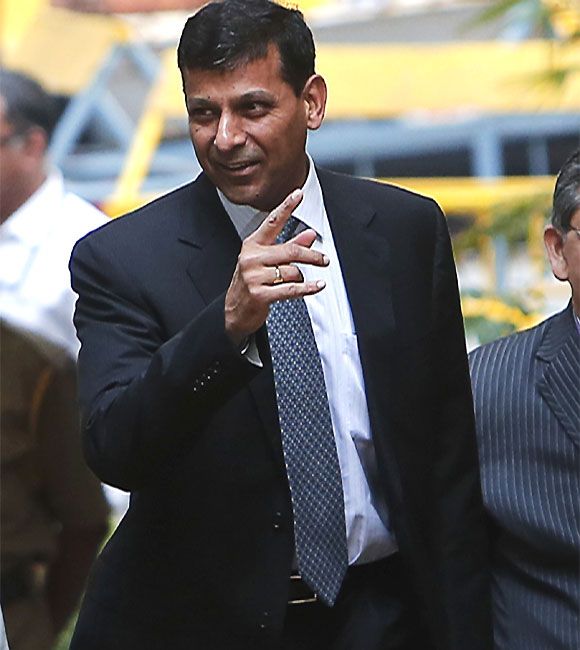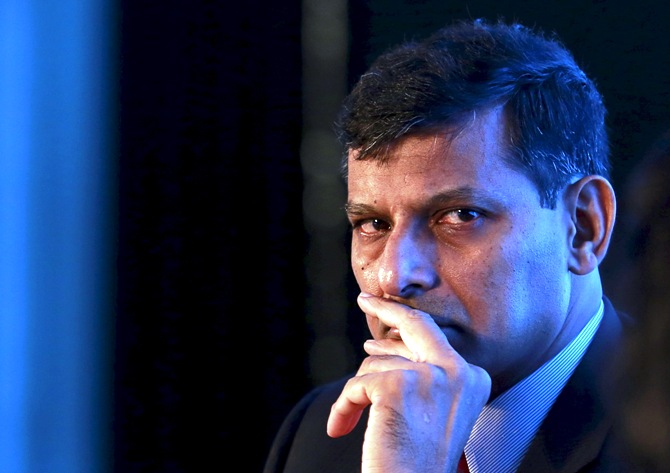
'RBI will continue to be vigilant'
'The biggest risk to inflation that we are watching is on the services side'
'Our economy has legacy problems to deal with and there are no silver bullets'
Edited excerpts from a media interaction with Reserve Bank of India Governor Raghuram Rajan, after the policy announcement.
Reason for 50 bps rate cut
Since our earlier review, the bulk of our conditions for cutting interest rates have been met. The January 2016 target of six per cent inflation is likely to be achieved.
Therefore, the focus should shift to bringing inflation to around five per cent by the end of 2016-17.
Road ahead
With weakening global activity since the earlier review, commodity prices will remain contained for a while.
With low industrial capacity utilisation, more domestic demand is needed to substitute for weakening global demand, so that the domestic investment cycle picks up.
The coming Pay Commission report could add substantial fiscal stimulus to domestic demand. But, the government has reaffirmed its desire to respect its fiscal target and improve the quality of spending.
Under these circumstances, the Reserve Bank intends to be accommodative, given its inflation goals, while recognising that continuing policy implementation, structural reforms and corporate actions will be the primary impetus for structural growth.
We do believe that investments, as well as durable goods purchases, are likely to respond more strongly if there's more certainty about the extent of monetary stimulus in the pipeline, even if transmission is slow.
Therefore, RBI has front-loaded policy action by reduction in the policy rate by 50 bps.
Given our year-ahead projections of inflation, this ensures a one-year expected treasury bill real interest rate of 1.5-2 per cent.
Focus on monetary policy
While the RBI stance will continue to be accommodative, the focus of monetary action for the near term will shift to working with the government to ensure impediments to the passing of the bulk of (our) 125 bps cut in the policy rate (since January) are removed.
This includes reviewing the small savings rate.
RBI will continue to be vigilant for signs that monetary policy adjustments are needed to keep the economy on the target disinflationary path.
Global environment
The global environment is looking weak, for a variety of reasons. Undoubtedly, this is not good news for India; no country is an island.
We can stand out as a country which still promises strong, sustainable growth.
The possibility of realising this opportunity should encourage us to redouble our efforts, to implement our past announcements and to undertake new reforms.
Our economy has legacy problems to deal with and there are no silver bullets, as I've said repeatedly.
Rate cuts by banks
We are going to be working very hard with the government on this.
The intent here is not to point fingers at other people but to start moving quickly on ensuring that transmission (of the policy cuts) does take place.
Of course, there are limits to how fast it can happen but we believe some will take place very soon, and more will take place over time.
We want to create conditions (for this), some of which will include things like changes in calculations in the base rate, will include government actions such as reviewing of the small savings interest schemes.
The intent is to work together to move forward to ensure transmission takes place.
Importance of the US Federal Reserve's (coming) rate rise
We clearly pay attention to what the Fed is doing, as well as other central banks, as it does affect the economy though foreign investment, So, we have to pay some attention to it.
But, I can't say it is the central issue we focus on when we discuss monetary policy.
It is one of the many concerns that we have to look at.
Lower overnight rates
For some time, there was excess liquidity but that has been reversed, post the tax outflows.
We have to manage this process and are trying to keep the weighted average call rate pretty close to the policy rate.
Risk to inflation
The biggest risk to inflation that we are watching is on the services side, where capacity is hard to determine.
Inflation in health care and education have been high for the past few years.
There are some signs of it coming down but that is a place we have to be watchful, in addition to the consequences of the monsoon and whether these are contained.
Food management can help in keeping food prices low. Where we need more capacity creation is in areas of services where we are possibly running into bottlenecks.
Inflation projection
We have said we aim to get inflation down to five per cent by the end of FY17.
We had announced a four per cent target by 2017-18 this year.
So, we are refining that by saying the interim target would be five per cent by the end of FY17.
That means one-and-a-half years to disinflate a little more.
The average for this year is 5-5.5 per cent.
Of course, we have benefited from some good external factors.
But, we have also had a very difficult monsoon, so we have to do a little more over the next year to get to the five per cent. We think it is feasible.
After all, we came down two percentage points over the past year.
Santa Claus is what someone called me earlier. . . you want to call me a hawk . . . My name is Raghuram Rajan and I do what I do.
Government bank capitalisation
The government has a game plan for capital raising by public sector banks.
Step one of the plan is to improve the governance structure in banks. Step two, which we are currently engaged in, is cleaning up banks' balance sheets.
After this, they can raise more capital and at, hopefully, more favourable prices given the clean-up and better governance.
These will allow banks not to meet the requirements but exceed that as they move on towards further growth.
We are working our way through both the steps.
There has been some change, and we need to do more on bank boards, the professionalisation of the boards.
Government clearly has indicated its desire not to intervene . . . to make the banks more independent.
This combination of actions over time will allow them to raise capital to meet the needs of Basel-III.
The last element which can be thought of is the change in organisational structure of the banks.
We have advocated moving towards holding company structure.
If they go towards that, banks will have the capacity to raise the capital at two levels, at holding company structure and bank level.
That could also help in easing some pressure on the government.
But, all this is predicated on having greater access to the market, having the ability for the government to unload its share and so on, which means the first two steps are needed.
Marginal cost calculation for base rate
We live in a marginal cost world. We don't live in an average cost world because incremental loans are made in response to competition from the market which don't have any memory.
They give loans at rates that prevail in the market at certain points.
Nevertheless, given the slow moving base rate, they have been quite fast in the cycle to adjust deposit cost downwards.
We have seen deposit interest costs coming down at sustainable level even though lending rates haven't come down that much.
So, the bottom line is, the market pressures and the competitive pressures from fast-moving banks like HDFC would force others to move towards a more marginal cost-based base rate.
We understand they have legacy issues.
We are examining some of them.
Overtime, if you look at what western banks do clearly, they use asset liability management to make sure they do not have huge mismatch.
Our banks will have to move towards that; we cannot continue protesting.
Image: Raghuram Rajan. Photograph: Reuters









